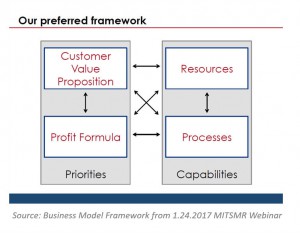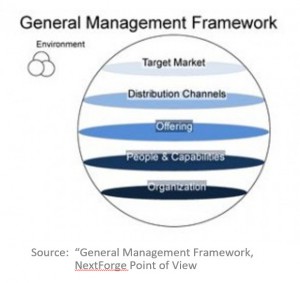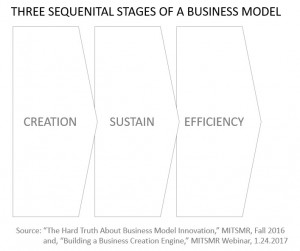Everyone wants a new one; Few are successful
“In a recent McKinsey poll, 84 percent of global executives acknowledged that innovation is extremely important to their growth strategies, yet a staggering 94 percent were unsatisfied with their own innovation performance.” From Competing Against Luck
How do you best support innovation and change? What interdependencies within your organization are impacted by necessary innovation? What type of innovation are you, or should you be, focused? Depending on the magnitude of the innovation/change, you may need to adjust or completely change your business model.
Early in my career I had the opportunity to assess and consolidate a number of functional business models for a client- boiling down the common and unique elements to create an integrated, enterprise-wide business model. Recently there is some research pointing not only to a simple model of the critical moving parts, but also insight into common stages of maturity relevant to business models and implications for leaders and managers driving innovation. Let’s begin with a common framework for thinking about the key elements of a business model.
Business model framework: A common vocabulary
Since at least 2008, Professor Christensen at Harvard’s business school has been advocating for a four-part, integrated business model. The following provides a quick introductory overview of the four, rather intuitive elements of this model. These definitions are from “The Hard Truth About Business Model Innovation” MITSloan Management Review, Fall 2016.
 Customer Value Proposition A product that helps a customer to more effectively, conveniently, and affordably do a job they’ve been trying to do (Note: A “customer’s job” is a technique to better understand value to the customer- “creating ¼ inch holes” are the value versus “buying ¼ inch drill bits”)
Customer Value Proposition A product that helps a customer to more effectively, conveniently, and affordably do a job they’ve been trying to do (Note: A “customer’s job” is a technique to better understand value to the customer- “creating ¼ inch holes” are the value versus “buying ¼ inch drill bits”)
Resources People, technology, products, facilities, equipment, brands and cash required to deliver this value proposition to targeted customers
Processes Ways of working together to address recurrent tasks in a consistent way: training, development, manufacturing, budgeting, planning, etc.
Profit Formula Assets and fixed cost structure, and the margins and velocity required to cover them
All four of the elements are interdependent. Any change in one will require an adjustment in the other three. The interdependencies provide much of the power and understanding this model. These pathways also enable the framework’s use as an analytic frame to enhance understanding of the implications of innovation and of supporting change.
Note in the graphic “Our preferred framework,” the left stack of Value Proposition and Profit Formula represent entity “Priorities.” With the right stack of Resources and Processes representing “Capabilities.”
Driving to an actionable level
In order to be actionable, we need to understand and align the capabilities side of the model, and how those capabilities link to the customer value proposition and the profit formula. From our work in a number of industries, the “General Management Framework” can provide a analytic framework for the next step into the details of aligning resources and processes.
 Target Market represents the ultimate consumer of your goods and products. Segmentation differentiates clusters within the market based on needs and preferences.
Target Market represents the ultimate consumer of your goods and products. Segmentation differentiates clusters within the market based on needs and preferences.
Distribution Channels are how you “sell into” your target segments depending on needs and preferences. The Internet has brought another distribution channel into play causing some companies to compete directly with their customers.
Offering is the combination of your products and services. Think of this as the Customer Value Proposition.
People and Capabilities represents most of your business’ assets including people, processes, technology and physical infrastructure, brand, industry relationships, patents, intellectual property, and many, many others.
Organization quite simply defines the structure, roles and scope of the departments, divisions, functions that make up your business.
When developing the General Management Framework, interestingly the missing link- not found in the functional models- was “Profitable Sale and Use.” We believe this concept of sales connects the General Management Framework (e.g., Target Market, Distribution Channels, Offering (CVP), People and Capabilities) to the Profit Formula (e.g., Revenue, Cost Structure, Margin, Resource Velocity). We strongly believe Profitable Sales and Use needs to be explicit in all business models.
Other Business Model Frameworks- A sidebar
If you are looking for an alternative business model framework, see Osterwalder’s Business Model Canvas which includes:
- Customer segments
- Channels and Customer relationships
- Value Proposition
- Key Activities and Key Resources
- Key Partners
- Cost Structure and Revenue Streams
Osterwalder, et al, also have a good workbook on a structured approach to Value Proposition Design if you are looking for “how to” approach to complement Christensen’s “job to be done” from Competing Against Luck.
Recent research: Business models follow a one-way, three-stage journey
This fall Christensen, Bartman, and van Bever published research findings on business model phases including two principles for consideration by all leaders and managers.
First, there are three discrete stages all business models follow in their maturity journey. Each stage focused on a different type of innovation, measurement and management.
 Creation Stage Primary focus is on market creation, jobs to be done, and maintaining a flexible business model.
Creation Stage Primary focus is on market creation, jobs to be done, and maintaining a flexible business model.
Sustaining Stage Primary focus is on how to continue and build on success, measuring income, and crafting processes.
Efficiency Stage Primary focus is on efficiency, measuring assets, and a rigid business model including return on capital.
Second, there is a single pathway or roadmap through the stages, and it is sequential. Research has shown the business model tightens over time for all the right reasons- to maximize profitable sales and use. Metrics continue to become more sophisticated and refined. And, managers spend more time on tweaking the capabilities to eke out incremental changes to the profit formula.
Implications and thoughts
We believe there are three key trends driving business change today including:
Accelerating Technological Innovation
Digital technological change is pervasive, is disruptive, and is changing most everything (e.g., cloud, big data, IoT, social business, mobile, consumerization of IT, machine learning/AI, robotics, genetics, 3D printing)
Blurring Boundaries
Technology innovation is accelerating the blurring of boundaries including geographical (e.g., globalization), industry (e.g., Apple in handsets and music, Amazon in retail and web services, Airbnb in hospitality), and those walls within the enterprise (e.g., go-to-market, supply chain, digital transformation).
Shifting Demographics
Changing workforce demographics create talent sourcing challenges and cognitive deficits. Millennial talent churn is occurring, while Baby Boomers are leaving and taking their expertise with them. And, in a parallel theme, shifting demographics are also impacting the marketplace.
These and other trends have shortened the life-span of companies. According to Innosight, “Half of the S&P 500 companies are expected to be replaced over the next 10 years.”
In order for your company to continue to compete, you will no doubt be faced with the need for significant innovation within your business model. This redefinition of your business will require a different capabilities’ stack and will require realignment of the elements of the General Management Framework.
Using the business model framework as a common language is helpful, particularly for functional managers who have not had much experience working across the enterprise. Defining and analyzing the pathways between the four elements (Customer Value Proposition, Resources, Processes, and Profit Formula) can help optimize for building and sustaining a successful enterprise at each stage of business model maturity- both today and tomorrow.
Depending on the size of your organization, you should consider your portfolio of business models. If, for example, most of your businesses are in the efficiency stage- what are you doing to prepare for the future? Determining the right blend of businesses in each of the three stages is essential for your business’ long-term health.
Once you have clear targets for your Create-Stage models, consider developing a process for enabling and supporting new business model creation. BCG advocates four approaches to business model innovation depending on impetus and focus (e.g., Reinvent, Maverick, Adventure and Adaption). It is possible this incubator may need to be outside of your current business, recalling the three stages are sequential. Perhaps you can “reframe your beliefs” to support innovation as McKinsey posits. Or, perhaps there are a number of companies with similar needs with whom you could fashion a non-competing network to create a supportive ecosystem.
“Over the long term, the greatest innovation risk a company can take is to decide not to create new businesses that decouple the company’s future from that of its current business units.”
Clay Christensen 1.24.2017 MITSloan Webinar
Endnotes and References
See Bartman, “Unlocking Growth and Resilience, Mastering business model innovation to survive and thrive in times of disruption,” Fall 2016 Trending@HBS Webinar Series- Harvard Business School Alumni Events, December 2, 2016. [Internet Webinar] From author’s notes: 2/3 of HBS MBAs take Prof. Christensen’s business model class- BSSE, Building and Sustaining a Successful Enterprise.
Christensen, Bartman, van Bever, “The Hard Truth About Business Model Innovation,” MITSloan Management Review (Fall 2016)
See Christensen, et al, Competing Against Luck, The story of innovation and customer choice (NY, NY: HarperCollins, 2016) for details of the “customer’s job” a manufacturer or a service provider is trying to accomplish- recently popularized as “Milk Shake Marketing.” Innovation quote can be found in the Introduction Chapter, page x
Christensen and van Bever, “Building a Business Creation Engine,” MITSloan Management Review Webinar, January 24, 2017. [Internet Webinar] [cited 1.30.2017] Video webinar available from http://sloanreview.mit.edu/webinar-building-a-business-creation-engine/on-demand/ Webinar slides available from http://marketing.mitsmr.com/events/HBS-Christensen-Webinar-2017.pdf
See de Jong and van Dijk, “Disrupting Beliefs: A new approach to business-model innovation,” McKinsey Quarterly, July 2015. [Internet] [cited 1.30.2017] http://www.mckinsey.com/business-functions/strategy-and-corporate-finance/our-insights/disrupting-beliefs-a-new-approach-to-business-model-innovation regarding testing beliefs for innovation- McKinsey’s five step model to “reframe” and four potential focus areas
See Johnson, Christensen and Kagermann, “Reinventing Your Business Model,” Harvard Business Review (December 2008) for Christensen’s initial article on the four-box business model framework (e.g., Customer Value Proposition, Resources, Processes, and Profit Formula)
See Lingardt and Ayers, “Driving Growth With Business Model Innovation,” BCG Perspectives, October 8, 2014. [Internet] [cited 1.30.2017] Available from https://www.bcgperspectives.com/content/articles/growth_innovation_driving_growth_business_model_innovation/ for a way of thinking of four scenarios for business model innovation based on a 2×2 with axes of Impetus (defend against industry decline or disruption; aspire for breakout growth) and of Focus (transform the core; Expand into noncore). Also, see the second paragraph of the article for more detail on BCG’s executive 2014 survey on innovation
Osterwalder and Pigneur, Business Model Generation, A handbook for visionaries, game changers, and challengers (Hoboken, NJ: John Wiley & Sons, 2010)
Osterwalder, et al, Value Proposition Design, How to create products and services customers want (Hoboken, NJ: John Wiley & Sons, 2014)
Reeder, “General Management Framework,” NextForge Point of View [Internet] [cited 1.30.2017] https://nextforge.com/?p=171

